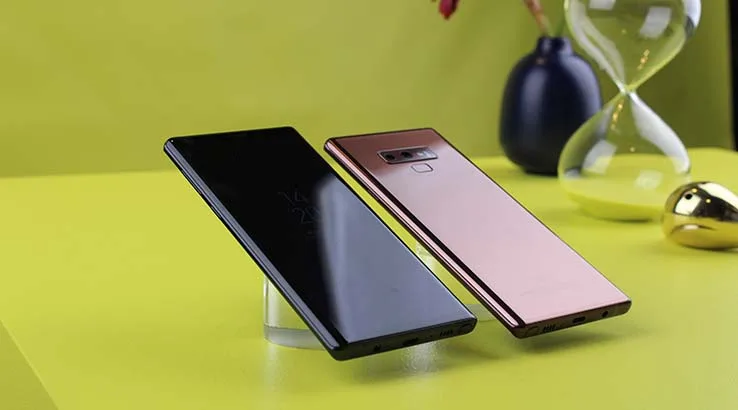Google Pixel 3 XL vs Samsung Galaxy Note9
![]()
How well does Google's new flagship compare to Samsung's exceptional Galaxy Note9?
Google Pixel 3 XL vs Samsung Galaxy Note9: What to look for

Google has today announced its biggest flagship phone, the Google Pixel 3 XL.
In the large phone world though, Samsung has a solid claim to being there first, having debuted the Galaxy Note range many years ago. Its latest iteration is the Samsung Galaxy Note9, a fine phone in its own right. If it's a big screen experience you crave, which phone should you opt for?
Google Pixel 3 XL vs Samsung Galaxy Note9: Power
![]()
The Pixel 3 XL uses the exact same recipe as many (but not quite all) of 2018's flagship Android handsets. Take one Snapdragon 845 processor, add 4GB RAM and stir until you've got a powerful handset.
The Galaxy Note9's recipe varies a little depending on which model you buy. Officially in Australia, we get the Note9 powered by Samsung's own Exynos 9810 processor, but international versions opt for the Snapdragon 845. The Snapdragon version of a given Galaxy phone typically has a slight performance edge over its Exynos rival, but sometimes at the cost of battery life. Either way, you'll be faced with more RAM, with 6GB on the 128GB model and 8GB on the 512GB variant.
More RAM should give the Note9 something of a performance edge, but the flip side is that Google can optimise performance on the Pixel 3 XL, which will be running Android 9 ("Pie") out of the box. The Note9 is a relatively recent handset, but it's running Android 8 ("Oreo") with Samsung's own launcher and software on top, adding some bloat. Samsung isn't notably rapid in bringing full version updates to its Android handsets, although it has picked up its game for security updates.
Where the Note9 will enjoy an edge in power over the Google Pixel 3 XL is in network speed. The Google Pixel 3 XL is no slouch as a category 16 phone capable of up to 1Gps down, but the category 18 modem in the Note9 trumps it with a peak download speed of (theoretically) up to 1.2Gbps.
Google Pixel 3 XL vs Samsung Galaxy Note9: Camera

The camera in the Google Pixel 3 XL is, surprisingly, only a single lens, but Google claims it can deliver superior performance through sheer force of software optimisation.
Google's promising a range of camera tweaks including a "top shot" feature, which uses a burst mode and machine learning to select the "best" picture and avoid closed eyes or sneezes, as well as improved low-light photography, although that won't be available at launch.
The Note9, on the other hand, builds on the excellent work done with the Galaxy S9+, with dual rear cameras, live focusing ability and very sharp low-light detection thanks to its variable aperture ability. It'll be interesting to see how Samsung's hardware-based approach and manual take on photography compares against Google's more software, AI-based approach.
Google Pixel 3 XL vs Samsung Galaxy Note9: Battery

Google drops a 3,430mAh battery into the Google Pixel 3 XL, which is a solid number and in the range that Samsung played in after the Note7 debacle saw it shy away from larger battery capacities.
However, those days are behind it, with a 4,000mAh battery pack that currently leads the field in our battery tests for every premium smartphone we've reviewed this year. In other words, Google's going to have to pull every software optimisation trick in the book to match its sheer battery stamina.
At least the Google Pixel 3 XL finally gets with the program in terms of offering full support for wireless charging.
Samsung's long been in the wireless charging camp, and the Samsung Note9 is no exception.
Google Pixel 3 XL vs Samsung Galaxy Note9: Pricing

One area where the Google Pixel 3 XL compares quite favourably against the Note9 is on price. The Google Pixel 3 XL will be available in Australia from 1 November, priced at $1,349 with 64GB of onboard storage or $1,499 if you want 128GB. You notably can't expand the storage on any Pixel phone, including the Pixel 3 XL, so what you buy is all you'll ever have.
You can drop a microSD card into the Samsung Galaxy Note9, but you also will pay a higher outright asking price. Samsung charges $1,499 for the 128GB/6GB model and $1,799 for the 512GB/8GB variant.
The Google Pixel 3 XL will be available on contract terms through Telstra, Optus and Vodafone when it launches on 1 November 2018. It's the first time that a Pixel phone has been available from carriers other than Telstra, but we're still waiting to see contract plans.
Check out our breakdown of all available Pixel 3 contract plans.
The Samsung Galaxy Note9 is already available from Telstra, Optus and Vodafone, and you can compare plan pricing below:

